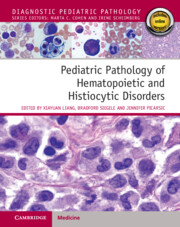Book contents
- Pediatric Pathology of Hematopoietic and Histiocytic Disorders
- Pediatric Pathology of Hematopoietic and Histiocytic Disorders
- Copyright page
- Epigraph
- Contents
- Contributors
- Section I General Hematology and Hematopathology
- Section II Non-Neoplastic Hematologic Disorders of Blood and Bone Marrow
- Section III Non-Neoplastic Disorders of Extramedullary Lymphoid Tissues
- Section IV Neoplastic Disorders of Bone Marrow
- Chapter 9 Ancillary Tests
- Chapter 10 Juvenile Myelomonocytic Leukemia (JMML)
- Chapter 11 Myeloid/Lymphoid Neoplasms with Eosinophilia and Gene Rearrangement
- Chapter 12 Myeloproliferative Neoplasms (MPNs)
- Chapter 13 Childhood Myelodysplastic Syndromes (MDSs)
- Chapter 14 Acute Myeloid Leukemia with Related Precursor Neoplasms
- Chapter 15 Myeloid Neoplasms with Germline Predisposition
- Chapter 16 Blastic Plasmacytoid Dendritic Cell Neoplasms (BPDCNs)
- Chapter 17 Acute Leukemia of Ambiguous Lineage
- Chapter 18 Precursor Lymphoid Neoplasms
- Chapter 19 Solid Tumor Metastasis to the Bone Marrow
- Section V Mature Lymphoid Neoplasms
- Section VI Histiocytic Disorders and Neoplasms
- Index
- References
Chapter 14 - Acute Myeloid Leukemia with Related Precursor Neoplasms
from Section IV - Neoplastic Disorders of Bone Marrow
Published online by Cambridge University Press: 25 January 2024
- Pediatric Pathology of Hematopoietic and Histiocytic Disorders
- Pediatric Pathology of Hematopoietic and Histiocytic Disorders
- Copyright page
- Epigraph
- Contents
- Contributors
- Section I General Hematology and Hematopathology
- Section II Non-Neoplastic Hematologic Disorders of Blood and Bone Marrow
- Section III Non-Neoplastic Disorders of Extramedullary Lymphoid Tissues
- Section IV Neoplastic Disorders of Bone Marrow
- Chapter 9 Ancillary Tests
- Chapter 10 Juvenile Myelomonocytic Leukemia (JMML)
- Chapter 11 Myeloid/Lymphoid Neoplasms with Eosinophilia and Gene Rearrangement
- Chapter 12 Myeloproliferative Neoplasms (MPNs)
- Chapter 13 Childhood Myelodysplastic Syndromes (MDSs)
- Chapter 14 Acute Myeloid Leukemia with Related Precursor Neoplasms
- Chapter 15 Myeloid Neoplasms with Germline Predisposition
- Chapter 16 Blastic Plasmacytoid Dendritic Cell Neoplasms (BPDCNs)
- Chapter 17 Acute Leukemia of Ambiguous Lineage
- Chapter 18 Precursor Lymphoid Neoplasms
- Chapter 19 Solid Tumor Metastasis to the Bone Marrow
- Section V Mature Lymphoid Neoplasms
- Section VI Histiocytic Disorders and Neoplasms
- Index
- References
Summary
Acute myeloid leukemia (AML) is a heterogenous group of diseases representing a clonal expansion of immature, non-lymphoid, bone marrow–derived cells that involve the bone marrow and blood and may also be present in other tissues [1,2]. In the pediatric population, AML is less common than lymphoblastic leukemia, accounting for approximately 18% of childhood leukemia diagnoses [3]. Although the cause of AML in many cases is unknown [1], as molecular genetics has been evolving over the last couple of decades, new molecular technology has enhanced our knowledge of the underlying genetic defects and gene mutations associated with the development of AML. It has been demonstrated that AML occurs more commonly in children with pre-existing genetic disorders, such as Down syndrome (DS) or Fanconi anemia, and familial cases of AML are now recognized [1]. A subset arises from pre-existing myelodysplastic syndrome (MDS) or after therapy for another neoplasm.
- Type
- Chapter
- Information
- Pediatric Pathology of Hematopoietic and Histiocytic Disorders , pp. 155 - 188Publisher: Cambridge University PressPrint publication year: 2024

